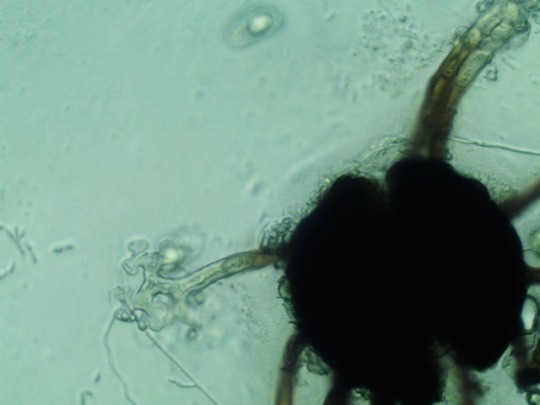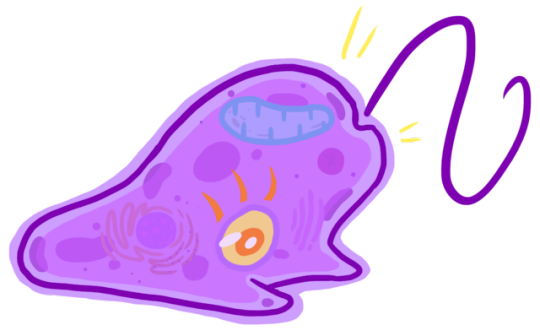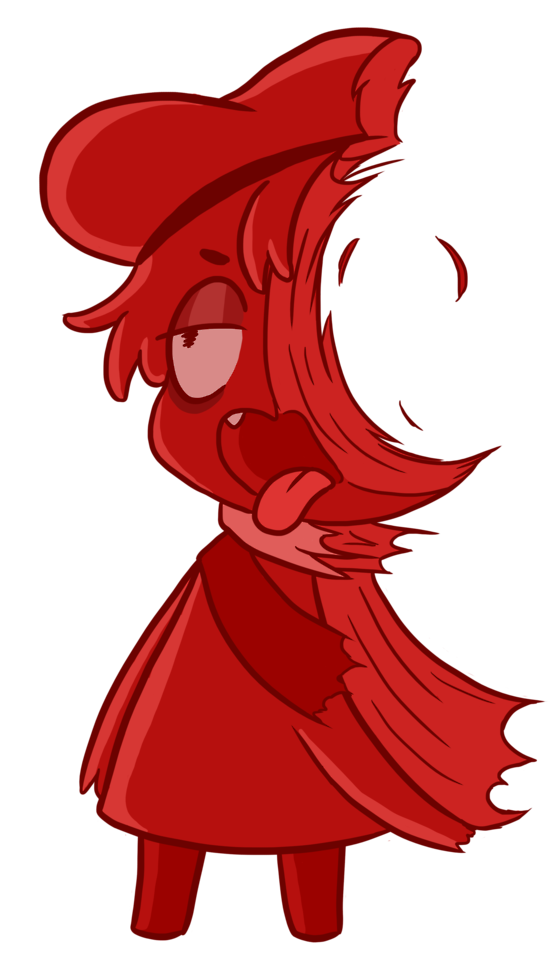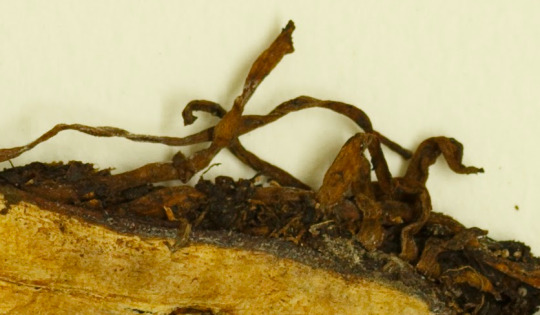#microfungi
Link
1 note
·
View note
Text
There are so few macrofungi that infect humans. Plenty of microfungi can, but very few macrofungi will actually go after animal flesh, living or dead. Always a pleasure (morbid though it be) to see one going the extra mile.
2 notes
·
View notes
Note
I don't think we need autistic biologists...
do you realize that autistic scientists are the most common form of scientist? if there weren't autistic people fixated on categorizing each small wasp in a taxonomic collection or looking at the life cycle of microfungi, biology wouldn't be as advanced as it is.
"Our findings confirm that individuals with an ASD are more likely than the general population and other disabilities groups to gravitate toward STEM. The STEM major rate (34.31%) for young adults with an ASD was not only higher than their peers in all 10 other disability categories, but also higher than the 22.80% of students in the general population that declared a major in STEM-related fields in postsecondary education (Chen and Weko 2009). In addition, this study found that young adults with an ASD in STEM fields were more likely than the general population to concentrate in science [12.12% vs. 8.3% (Chen and Weko 2009)]"
Xin Wei, Jennifer W. Yu, and Jose Blackorby, (2013, Jul). Science, Technology, Engineering, and Mathematics (STEM) Participation Among College Students with an Autism Spectrum Disorder. National Library of Medicine. Recovered on July 4th 2022, from https://www.ncbi.nlm.nih.gov/pmc/articles/PMC3620841/#__ffn_sectitle
60 notes
·
View notes
Photo










Salt Valley Overlook, Arches National Park (No. 1)
An abundance of wildlife occurs in Arches National Park, including spadefoot toads, antelope squirrels, scrub jays, peregrine falcons, many kinds of sparrows, red foxes, desert bighorn sheep, kangaroo rats, mule deers, cougars, midget faded rattlesnakes, yucca mothes, western rattlesnakes, and collared lizards.
Plants also dominate the landscape in the park, including prickly pear cactus, Indian ricegrass, bunch grasses, cheatgrass, lichen, moss, liverworts, Utah juniper, Mormon tea, blackbrush, cliffrose, four-winged saltbrush, pinyon pine, evening primrose, sand verbena, yucca, and sacred datura.
Biological soil crust consisting of cyanobacteria, lichen, mosses, green algae, and microfungi is found throughout southeastern Utah. The fibrous growths help keep soil particles together, creating a layer that is more resistant to erosion. The living soil layer readily absorbs and stores water, allowing more complex forms of plant life to grow in places with low precipitation levels.
Source: Wikipedia
#Salt Valley Overlook#Arches National Park#La Sal Mountains#flora#desert#bush#blue sky#clouds#geology#Colorado Plateau#tourist attraction#USA#red rock#rock formation#landscape#countryside#Fiery Furnace#Grand County#Utah#Western USA#original photography#summer 2022#impressive landscape#hiking#travel#vacation
3 notes
·
View notes
Text
Mycotoxin Testing Long Island
Angstrom Testing Services is registered with the EPA, and each of our inspectors are licensed by the EPA to conduct XRF lead paint inspections and lead risk assessments.
0 notes
Text
ANTI-MICROBIAL PROPERTIES OF OLIVE OIL
I have been consuming a tablespoon of extra-virgin olive oil daily for over 2 decades. Many were asking why I do that, here is why…
Olive oils with a high polyphenol content (that is, extra-virgin olive oils) have been shown to prevent or delay the growth of pathogenic bacteria and microfungi, and the oil is therefore considered antimicrobial.
This phenomenon is specifically attributed to…

View On WordPress
0 notes
Text
Chromium(2) and also Molydenum(2) Things using a Pyridyl-Mesoionic Carbene Ligand: Architectural, (Spectro)electrochemical, Photochemical, and also Theoretical Deliberate or not.
biloba callus way of life.Qualifications The actual cAMP-metabolising compound, phosphodiesterase 4 (PDE4), continues to be suggested as a factor in many immune system replies, which includes tumour necrosis aspect alpha (TNF leader) manufacturing. Up to now, number of information have immediately dealt with whether synovial cytokine along with chemokine production is altered simply by PDE4. Objective Employing specific PDE4 inhibitors, roflumilast plus 2 book inhibitors, INH 0061 and also INH 0062, the particular creators researched the effect involving PDE4 hang-up in proinflammatory cytokine along with chemokine launch from primary rheumatoid arthritis (RA) synovial absorb headgear as well as in a new macrophage Big t mobile or portable co-culture analysis method. Results All PDE4 inhibitors dose-dependently diminished the discharge regarding TNF alpha dog via principal synovial tissue layer ethnicities (n=5), 50 percent maximal inhibitory focus (Ed(50)) 300-30 nM, s < Zero.05. Likewise, a significant suppression within the release the particular proinflammatory chemokines, monocyte chemoattractant protein-1 (MCP-1), macrophage inflammatory protein (MIP)-1 leader, MIP-1 'beta' (IC Methotrexate mw (Fifty) 300-30 nM) and regulated about initial typical T-cell portrayed and produced (RANTES) (IC(50) Three or more nM) have also been witnessed, g < 0.05. While interleukin A single 'beta' seemed to be lowered, this didn't achieve the Ed(50). These kind of studies were more established in the macrophage Capital t cell co-culture technique, demonstrating the need for PDE4 paths throughout regulating cytokine/chemokine launch inside a mobile discussion implicated in inflammatory synovitis. Following research using the man monocytic mobile or portable range U937 additionally demonstrated cytokine legislations with PDE4 knockdown employing a little interfering RNA method. Conclusion These data present immediate proof of PDE4-dependent paths in individual RA synovial inflamed cytokine as well as chemokine discharge and may even provide a story tactic for continual auto-immune problems like RA.Aims: This examine is centered on the possibility to manipulate microbe toxic contamination associated with strawberries by simply chlorophyllin (Na-Chl)-based photosensitization. Furthermore, photosensitization-induced consequences in essential good quality highlights of taken care of berries had been looked at. Methods and Outcomes: Strawberries had been inoculated using Listeria monocytogenes ATC(L3)C 7644, over loaded in A single mmol l-1 Na-Chl for min and also lit for 40 minutes using seen lighting (lambda Equals 300 nm, power occurrence A dozen mW cm-2). Outcomes revealed that your decontamination of bananas making use of photosensitization has been 98% in comparison to management sample. Natural yeasts/microfungi as well as mesophiles ended up inhibited simply by Eighty six as well as 97%, correspondingly. The actual life-span associated with dealt with strawberries had been lengthy by simply 2 days. The total antioxidising exercise of handled berries improved by 19%. Absolutely no affect how much phenols, anthocyanins or perhaps surface coloring was recognized. Conclusions: Photosensitization may be a powerful, nonthermal and beneficial to our environment bacterial decontamination strategy which increases the particular life expectancy regarding strawberries without bad affect antioxidising task, along with phenols, anthocyanins or even color creation. Significance and also Effect of the Study: Experimental information secure the idea that Na-Chl-based photosensitization can be quite a useful gizmo for the future growth and development of nonthermal food preservation engineering.
#Bioactive Compound Library#ALK inhibitor#Spartalizumab#Infliximab#Obinutuzumab#Ustekinumab#Secukinumab#Daratumumab#Empagliflozin#Cabotegravir#Oxaliplatin#Chloroquine#Methotrexate#Dexamethasone#Cyclophosphamide#Plerixafor#Resveratrol#Curcumin#Estradiol#Simvastatin
1 note
·
View note
Photo


A new Hoppers and Fungi, completely fantasist, I’m not even pretending to be close to reality this time xD
My cheap scanner doesn’t render super well, so first I started correcting in photoshop to make it more like the original, then I went on and and tweaked it even further.
#art#color painting#color markers#mixed media#Illustration#digital painting#beetle#microfungi#leafhoppers
11 notes
·
View notes
Photo




Powdery mildew (Podosphaera amelanchieris on Amelanchier lamarckii) chasmothecia with dichotomous appendages.
#fungi#fungus#mycology#plant pathology#plant disease#microscopy#400X#powdery mildew#erysiphales#ascomycota#parasite#microfungi#ascus#ascospores#spores
113 notes
·
View notes
Photo





A revived AU of mine, one I like to call the Bloodwork AU… I swear it was an original idea left unfinished until Cells at Work revived it. P.S. I did not promise this would be educational or accurate; don’t sue me.
Pathogens!!
Viruses: Not dead, not alive, but simple armored strains of DNA or RNA that must insert itself into living cells in order to multiply. Callously hunts down innocent cells to drill its genetic information into and ignores any irrelevant forces. A master of disguise since even if the original is neutralized, if it has infected a cell, more will eventually take its place. When inactive, it spends its free time drilling holes into membranes. Cells infected with viral information will feel compelled to break their personal protocol to defend their viral information until it emerges, destroying them.
Bacteria: Squishy, living organisms that wreak havoc loose in the bloodstream. There’s many different kinds, but this fella is a very simple bacterium. Its here for food, a warm home, though unfortunately, it has loose definitions of “food”. May not be bright enough to run from an activated neutrophil, but once it gets going, that flagellum makes it a speedy swimmer!
Microfungi: Hard cased spores of various fungi that normally dwell on the exterior of the body. But it would be a lie to say that abrasions don’t result in these microfungi infiltrating the human body. Particular strains can cause havoc in the gut. On the blacklists of both neutrophils, eosinophils, and macrophages.
Sickle Cell: Red blood cells missing enough hemoglobin, such that they form sharp but flaccid sickle shapes and pile up in blood vessels, blocking healthy cells from passing. They don’t mean harm, and they are fully aware how much of a bother they are. Small spurts of them can be seen following a monocyte, often on their way to a macrophage. The missing hemoglobin doesn’t hurt, but it does itch.
Cancer Cell: Cells that come out mutated, unable to stop duplicating themselves, making more defective cells. Hundreds of them are made every moment, but are eliminated immediately before they become an issue. However, some may escape scrutiny and when they’re discovered, have become a much bigger problem than before.
(Pictured cancer cell is a defective neutrophil. I chose him because he’s soft and cute. Side note: I have no idea if neutrophils can really be cancerous, the internet yielded nothing for or against that notion. However, apparently their presence can make tumors more aggressive! Who knew?)
#nerd stuff#my art#scarletta doodles#ocs#bloodwork au#aus#virus#bacteria#microfungi#sickle cell#cancer cell#//body horror#//facial horror#red blood cell#neutrophil
16 notes
·
View notes
Text
2 notes
·
View notes
Text
No lie, as a disabled person, i dont want to hear one more god damn peep of "WHAT ABOUT DISABLED PEOPLE???" when people bring up environmental solutions that OBVIOUSLY are for the majority of us who can physically manage these adjustments. Stop making something about you when it isnt.
I dont want to hear the straw ban is ableist anymore. That personal straws arent an acceptable alternative because someone could trip and stab themselves with a metal straw. No joke. I read that. Fuck the sea turtles whales and birds with plastic bursting their bellies open, who cares about the micro plastics we're breathing into our spongy lungs at a rate of about 11 bits per hour, who gives a shit about plastic in the soil killing off earth worms and microfungi ruining the ability for the soil to hold excess carbon, not a fucking care about plastic particles snowing in mountainous regions where humans dont even live......
because a hypothetical someone could stab themselves with a straw.
#the fucking entitlement#climate change solutions#abelism#disabled people are included#not a pass to be a piss baby#making us all look bad#fucking lawn dart logic there
14 notes
·
View notes
Note
"Although Stylites possesses some anomalies- it lacks stomata..." This phrase made me terrified yet even more intrigued with these weird little buggers. Plants are already weird enough and then theres this one. I love it. Thank you for making your paper available to read!!
fun fact, this is actually the one species i’ve gotten to see a bisected specimen of! our herbarium’s small isoetes collection had a few sent up from Peru in the 50s, and they’d been cut in the middle and pressed open to show the anatomy. i actually ended up using the digitization setup to take some Really High Def pictures of them (we are FAAARRR from having all of the stuff in my uni’s herbarium digitized. they just got done with the microfungi, i dont even think they’ve even started on the angiosperms, forget the Strange Lads in the lycophyte lockers....but then again funding is hard to come by for herbariums and all that). anyway, behold:

look at those leaf traces!!!

i love this specimen in particular because you can really see how their roots are actually fucked up leaves. like its one of those things where you don’t really think about it until you actually take a close look, and then you’re like ‘oh, yeah, that’s definitely Not How Normal Plants Look’. compare:


she.....she just made some tubes huh.....really just Did That and gave one some chlorophyll....
#they're SO WEIRD#we have like 8 and i feel blessed to be able to look through them#i took a lot of these actually#but theyre in photoshop files that take forever to load#so i just loaded up one and took some screenshots#asks#plont asks#isoetes#honeybitz
474 notes
·
View notes
Photo

New Jersey-based Modern Meadow’s revolutionary products are made in a lab because the company believes in “a future where animal products are animal-free.” The start-up’s new vegan leather, made with a process similar to brewing beer, will possess a striking likeness, in terms of smell and texture, to animal hide... Additionally, Modern Meadow’s bioleather can be made to any specified color, thickness, or texture.“We have engineered a strain of yeast — like a cousin of what you’d use to brew beer — which can produce collagen through fermentation,”
(via Vegan Biotech Company 'Poised to Disrupt' the $100 Billion Leather Industry)
0 notes
Quote
...it seems reasonable to propose that even the maximal estimates of endophyte diversity (i.e. four endophytes per plant species) have been conservative. However, even if there were only 1 million endophytic fungi in plants, that would still account for 1 in 14 or even 1 in 10 species of life.
From “A community of unknown, endophytic fungi in western white pine” Ganley, Brunsfeld, Newcombe 2004. RESPECT THE FUNGI!
0 notes
Text
Flower power: botanical art takes root at Saatchi Gallery
Flower power: botanical art takes root at Saatchi Gallery
From flowers in the Andes Mountains to microfungi. A new exhibition at London’s Saatchi Gallery is showcasing some of the world’s most fascinating flora.
READ MORE : https://ift.tt/ZEJNRGO
Subscribe to our channel: https://www.youtube.com/c/euronews?sub_confirmation=1
Watch our LIVE here: https://www.youtube.com/c/euronews/live
Subscribe to our thematic channels:
NoComment:…
View On WordPress
0 notes